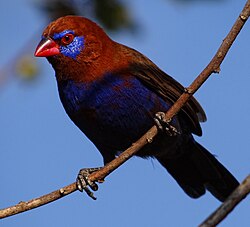| Purple grenadier | |
|---|---|
 | |
| Male in Serengeti National Park | |
 | |
| Female, in Serengeti National Park | |
| Scientific classification | |
| Kingdom: | Animalia |
| Phylum: | Chordata |
| Class: | Aves |
| Order: | Passeriformes |
| Family: | Estrildidae |
| Genus: | Granatina |
| Species: | G. ianthinogaster |
| Binomial name | |
| Granatina ianthinogaster (Reichenow, 1879) | |
The purple grenadier (Granatina ianthinogaster) is a common species of estrildid finch found in eastern Africa.
